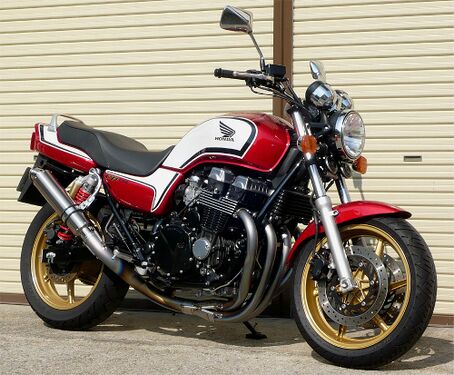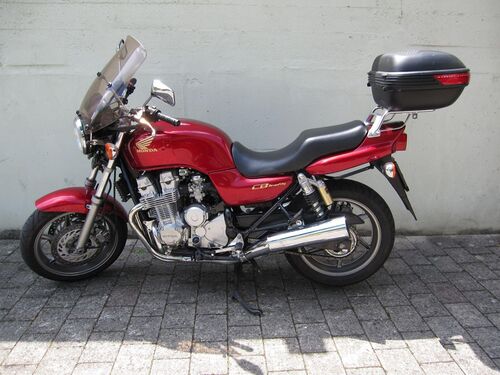The model of the classic road motorcycle `` Honda CB 750 begins its history since 1969, but the most interesting and used are still models, starting from 1991 and produced until 2003 (for the Japanese market - until 2008) ... The appearance of this model was due to the desire of Honda to compete with the then popular model Kawasaki Zephyr 750.
In 2007, Honda decided to resurrect the legendary motorcycle with the release of the Honda CB 750 Special Edition in silver colors. This version of the motorcycle was only sold in Japan.
A feature of the Honda CB 750 is the 747 cc in-line 4-cylinder air / oil-cooled engine. see, delivering 75 hp. power and almost 64 Nm of torque. The motor is equipped with hydraulic lifters and does not require periodic adjustment of valve clearances.
The main modifications of the Honda CB 750:
- Honda CB 750 F2 Seven Fifty (1992-2001) - European version. The model features a classic look, dual front brakes and a rear disc brake. In Japan, the model was available from 1992 to 1995. In 2001, the model undergoes minor changes and is produced in Japan until August 2008.
- Honda CB 750 Nighthawk (1991-2003) - American version. The model has a more cruiser appearance, with one disc brake at the front and a drum brake at the rear.
The Honda CB750 was often used for training in motorcycle schools, so you can find “strangled” training versions of this motorcycle on the market. They can be distinguished by black mufflers, the absence of a handle for the passenger, a black dashboard body (instead of chrome "cups"), the absence of remote reservoirs on the rear shock absorbers, the presence of a fan on the oil cooler (not always), a 2-piston rear caliper and hydraulic clutch. Very often, training versions are trying to be visually remade into full-strength ones, therefore, training models offered on the market may not always contain all of the listed differences.
The main competitors of the Honda CB 750 in the class:
Photos
Specifications
Specifications Honda CB 750 (F2 Seven Fifty, Nighthawk):
| Model | Honda CB 750 (F2 Seven Fifty, Nighthawk) |
|---|---|
| Motorcycle type | road (classic) |
| Release year | 1991-2003 (2008) |
| Frame | steel duplex |
| Engine type | 4-cylinder, 4-stroke, in-line |
| Working volume | 747 cc cm. |
| Bore / stroke | 67.0mm x 53.0mm |
| Compression ratio | 9.3: 1 |
| Cooling | air-oil |
| Number of valves per cylinder | DOHC, 4 valves per cylinder (with hydraulic lifters) |
| Fuel supply system | carburetor, 4x Keihin 34 mm (VE66X, VE77X - CB750 (1991-2000),
VENAC - CB750 (2001-2008) |
| Ignition type | transistor |
| Maximum power | 75 hp (55 kW) at 8500 rpm |
| Maximum torque | 64 Nm (6.5 kgm) at 7500 rpm |
| Gearbox | 5-speed |
| Drive type | chain |
| Front tire size | 120 / 70-17 58V - CB750 F2 Seven Fifty
110 / 80-18 58H - CB750 Nighthawk |
| Rear tire size | 150 / 70-17 69V - CB750 F2 Seven Fifty
140 / 70-17 66V - CB750 Nighthawk |
| Front brakes | 2x296mm discs, 2-piston calipers - CB750 F2 Seven Fifty
1 disc 296 mm, 1-piston caliper - CB750 Nighthawk |
| Rear brakes | 1 disc 240mm, 1-piston caliper - CB750 F2 Seven Fifty
drum - CB750 Nighthawk |
| Front suspension | 41mm telescopic fork, 130mm travel (140mm - Nighthawk) |
| Rear suspension | linkage with two shock absorbers (adjustable preload), stroke - 110 mm |
| Length | 2220 mm (2185 mm - Nighthawk) |
| Width | 780 mm (800 mm - Nighthawk) |
| Height | 1100 mm (1135 mm - Nighthawk) |
| Wheelbase | 1495 mm (1505 mm - Nighthawk) |
| Saddle height | 795 mm (780 mm - Nighthawk) |
| Acceleration to 100 km / h | 3.9 sec |
| Maximum speed | 205 km / h (180 km / h - Japanese versions) |
| Fuel tank capacity | 20 L (including 3 L reserve) - CB750 F2 Seven Fifty
18 L (including reserve - 3 L) - CB750 Nighthawk |
| Motorcycle weight (dry) | 215 kg - CB750 F2 Seven Fifty
210 kg (212 kg - California version) - CB750 Nighthawk |
| Motorcycle weight (curb) | 235 kg - CB750 F2 Seven Fifty
226 kg (228 kg - California version) - CB750 Nighthawk |
Fuel consumption
The officially declared fuel consumption of the Honda CB 750 is 6.1 liters per 100 kilometers. The exact value depends on the riding style and technical condition of the motorcycle.
Documentation



